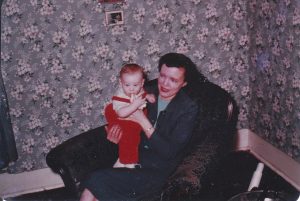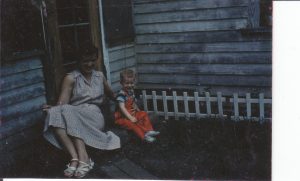Using a Single Memory to See What You Can See
 My Aunt Gladys, my mother’s sister, died in 1961 when I was five years old. I’d never really known her because she lived in Germany where her husband was stationed, lived there, that is, before she was diagnosed with lung cancer and the U.S. Army allowed my Uncle Duane to transfer to Washington, D. C., so Gladys could get treatment at Walter Reed Hospital. I only have one memory of being with her, although family photographs offer evidence of her holding me when I was a baby and playing with me when I was a toddler. These photographs were taken at my grandmother’s house where Gladys must have been visiting.
My Aunt Gladys, my mother’s sister, died in 1961 when I was five years old. I’d never really known her because she lived in Germany where her husband was stationed, lived there, that is, before she was diagnosed with lung cancer and the U.S. Army allowed my Uncle Duane to transfer to Washington, D. C., so Gladys could get treatment at Walter Reed Hospital. I only have one memory of being with her, although family photographs offer evidence of her holding me when I was a baby and playing with me when I was a toddler. These photographs were taken at my grandmother’s house where Gladys must have been visiting.
When I was four, my parents and I rode a train from our home in rural southeastern Illinois to Washington, D. C., so my mother could see Gladys. My mother was the oldest of six children and had assumed a maternal role in the lives of her siblings. She’d helped raise them, and her caretaking stayed with her throughout her life. The visit we paid in 1960 would be the final time she would see Gladys. I have one sharp memory from that visit that has stayed with me throughout the years.
Even now, when I close my eyes, I can see Gladys in black pedal pushers and a sleeveless white blouse that buttoned up the back, leaning over the gas ring of her stove, so she can light her cigarette. Her bobbed black hair is graying. Her lipstick is a bright red. She’s lost so much weight, her arms are thin, the backs of her hands heavily veined. Her fingers tremble. She straightens with her lit cigarette, taking a deep drag, and holding it before she exhales a stream of smoke. I remember a window above the sink. I remember my mother in the narrow kitchen fanning away the smoke. I’m there, too, watching, maybe trying to hide behind my mother’s skirt because I’m a shy child, and I don’t know my aunt, and I’ve never seen someone light a cigarette the way she has, and I suppose for that reason everything about this moment seems foreign to me—it’s so distant from the world I’ve left, a world where neither my mother or father smokes and where the gas burner on our stove is used for cooking and to make the Jiffy Pop popcorn I like so much. I’m no longer in that world as I stand in my aunt’s kitchen. I’m in Gladys’s world, one of sickness and fear and mortality where she can turn to my mother, her big sister, with a nearly defiant look on her face as she spews that stream of smoke, almost as if to say, this is it. This is the end. There’s nothing you can do to help me.
 When I think of my aunt Gladys now, this is the tableau I recall, the one that says so much about her, a woman who left the insular rural world of southeastern Illinois, eventually married a career military man, and traveled all the way to Germany. In adulthood, I’d come to learn more about her—a child given up for adoption, a first marriage gone wrong. My older cousin would tell me she was strongheaded. “She made her own path,” he’d say, “but she could be funny, too. She aways liked a good laugh.” She was in short, everything my mother wasn’t. My mother was a woman of duty and compassion. How she must have ached to know she couldn’t save her sister.
When I think of my aunt Gladys now, this is the tableau I recall, the one that says so much about her, a woman who left the insular rural world of southeastern Illinois, eventually married a career military man, and traveled all the way to Germany. In adulthood, I’d come to learn more about her—a child given up for adoption, a first marriage gone wrong. My older cousin would tell me she was strongheaded. “She made her own path,” he’d say, “but she could be funny, too. She aways liked a good laugh.” She was in short, everything my mother wasn’t. My mother was a woman of duty and compassion. How she must have ached to know she couldn’t save her sister.
My point for writers in all of this? Sharpen your focus. Zero in on the small detail, the one that stands out, and from there widen your vision to see what that detail invites you to see. I remember my aunt’s face close to the flames of that gas burner. I remember her pedal pushers, her white blouse, her red lipstick. I remember the blush she left on the filter when she held it away from her lips so she could exhale.
Thank you Lee. It gives me a little more information about her.
Nancy, I thought of you when I wrote this.
So this was your grandmother Read’s first child? I dont remember ever hearing about her. I loved your mom and Homer. They had a way of making children feel important. I love to read your stories about growing up. Brings back so many memories. Even though I’m not writer. When you talk about your Aunt lighting her cigarette and remember what she was wearing, I can picture it in my mind. I remember those pedal pushers and sleeveless shirts back in the day. And I think thats good writing!
My mother was the oldest of six children. The birth order was my mother, Jim, Homer, Gladys, Anna, and Harry. Jim lived in St. Joseph, MO. Gladys left Richland County for LaGrange, IL, and Harry lived in Charleston, IL. Anna married Richard Knockmuhs and lived in the country outside West Salem.
Lovely writing
Thank you!
May I use this post as I begin a class this month teaching adults to write about their lives? You do such an amazing job of creating images that fill all the senses. We learn so much about Gladys – her looks, her attitude, her difficult childhood, and her defiance.
Yes, absolutely!